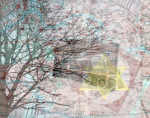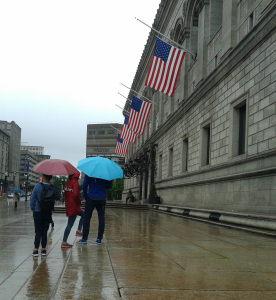 Gillham, David, R. City of Women, Putnams, 2012.
Gillham, David, R. City of Women, Putnams, 2012.
Berlin 1943 is a city of women. The majority of the men are involved in the war in some capacity. Sigrid’s Schröder’s bank employee husband is at the Eastern Front while Sigrid works in the Patent Office. There are food shortages and bombing raids. Berliners endure the privations and wonder what they can actually believe. The news from Stalingrad is disconcerting. Neighbour distrusts neighbour. Perhaps the only escape is a couple of hours or so in the cinema. Who knows what release is offered in the darkness?
 Gillham’s City of Women is set against this background. From its opening chapter, the novel held me in the way a crime thriller holds the reader. I needed to know what happened next, how everything would turn out. However, this novel far transcends genre fiction. It has its roots in Gilmore’s fascination with a lost Berlin “Inaccessible and forgotten” (387-88) and his discovery that “through fiction . . . [he could] resurrect the entire city, and the people in it” (388).
Gillham’s City of Women is set against this background. From its opening chapter, the novel held me in the way a crime thriller holds the reader. I needed to know what happened next, how everything would turn out. However, this novel far transcends genre fiction. It has its roots in Gilmore’s fascination with a lost Berlin “Inaccessible and forgotten” (387-88) and his discovery that “through fiction . . . [he could] resurrect the entire city, and the people in it” (388).
 In some ways, the novel did feel to me something akin to an elegy for the lost architecture of a city way older than the National Socialist Party but parts of which disappeared for good or are buried because of that party. While the characters and events Gillham creates could probably have been set in any German city in 1943, the Berlin he creates is an integral part of the story. His evocation of the city is superb: one feels the cold, smells the dust from the fallen bombed buildings, endures the crush on the tram, and out of the corner of one’s eye sees the Berliners moving nervously through their war damaged city, not meeting each other’s eyes, wondering at the wounded soldiers—could things really be going well—appearing unconcerned and co-operative if stopped by the police, hiding their secrets. In amongst them all are the “U-boats” (107) those without the right papers, dissidents, hidden Jews.
In some ways, the novel did feel to me something akin to an elegy for the lost architecture of a city way older than the National Socialist Party but parts of which disappeared for good or are buried because of that party. While the characters and events Gillham creates could probably have been set in any German city in 1943, the Berlin he creates is an integral part of the story. His evocation of the city is superb: one feels the cold, smells the dust from the fallen bombed buildings, endures the crush on the tram, and out of the corner of one’s eye sees the Berliners moving nervously through their war damaged city, not meeting each other’s eyes, wondering at the wounded soldiers—could things really be going well—appearing unconcerned and co-operative if stopped by the police, hiding their secrets. In amongst them all are the “U-boats” (107) those without the right papers, dissidents, hidden Jews.
 At times, the mood of the novel reminded me rather of Graham Greene’s The Third Man, and I was unsurprised to learn that Gillham’s initial training was in screenwriting. Further, it’s interesting to me at least that when I visualized the events of The City of Women I saw little colour. Berlin and its people as evoked by Gillham were a kaleidoscope of greys, like a black and white movie. The plot, of course, is more developed than that of Greene’s novella, which emerged as a result of his work with Carol Reed on the film. So, too, are the characters. What the two share is the sense of moral ambiguity and shifting loyalties; their endings, too, are thematically satisfying, but in terms of suggesting what might come next, they don’t. Gillham gives us no epilogue, no jump forward in time. The reader is left in the same position as Sigrid. She doesn’t know what will happen next; she knows only that she has made a commitment.
At times, the mood of the novel reminded me rather of Graham Greene’s The Third Man, and I was unsurprised to learn that Gillham’s initial training was in screenwriting. Further, it’s interesting to me at least that when I visualized the events of The City of Women I saw little colour. Berlin and its people as evoked by Gillham were a kaleidoscope of greys, like a black and white movie. The plot, of course, is more developed than that of Greene’s novella, which emerged as a result of his work with Carol Reed on the film. So, too, are the characters. What the two share is the sense of moral ambiguity and shifting loyalties; their endings, too, are thematically satisfying, but in terms of suggesting what might come next, they don’t. Gillham gives us no epilogue, no jump forward in time. The reader is left in the same position as Sigrid. She doesn’t know what will happen next; she knows only that she has made a commitment.
 Sigrid is called upon to make decisions, to commit to something more than mere survival, and it is these ethical questions that hold the reader’s attention and lie at the heart of the novel: what will Sigrid do, and why does she do it? What would our answer be to these questions? How do we define love, trust, and betrayal? Gillham doesn’t preach. He doesn’t present us with a didactic conclusion. Rather, he shows us the options. Do we choose action or inertia? Honour or self-interest? How do we tell the difference?
Sigrid is called upon to make decisions, to commit to something more than mere survival, and it is these ethical questions that hold the reader’s attention and lie at the heart of the novel: what will Sigrid do, and why does she do it? What would our answer be to these questions? How do we define love, trust, and betrayal? Gillham doesn’t preach. He doesn’t present us with a didactic conclusion. Rather, he shows us the options. Do we choose action or inertia? Honour or self-interest? How do we tell the difference?
According to an interview Gillham gave to Ashleigh Andrews Rich of The Washington Independent Review of Books in January 2013, http://www.washingtonindependentreviewofbooks.com/features/author-qa-with-david-r-gillham he was working on another novel. I can find no mention of it on Gillham’s own website http://davidrgillham.com, which I accessed today, but I hope it comes out soon.
Advertisements Share this:





![thugsOakland_4x6_bk[1094]](/ai/084/553/84553.jpg)